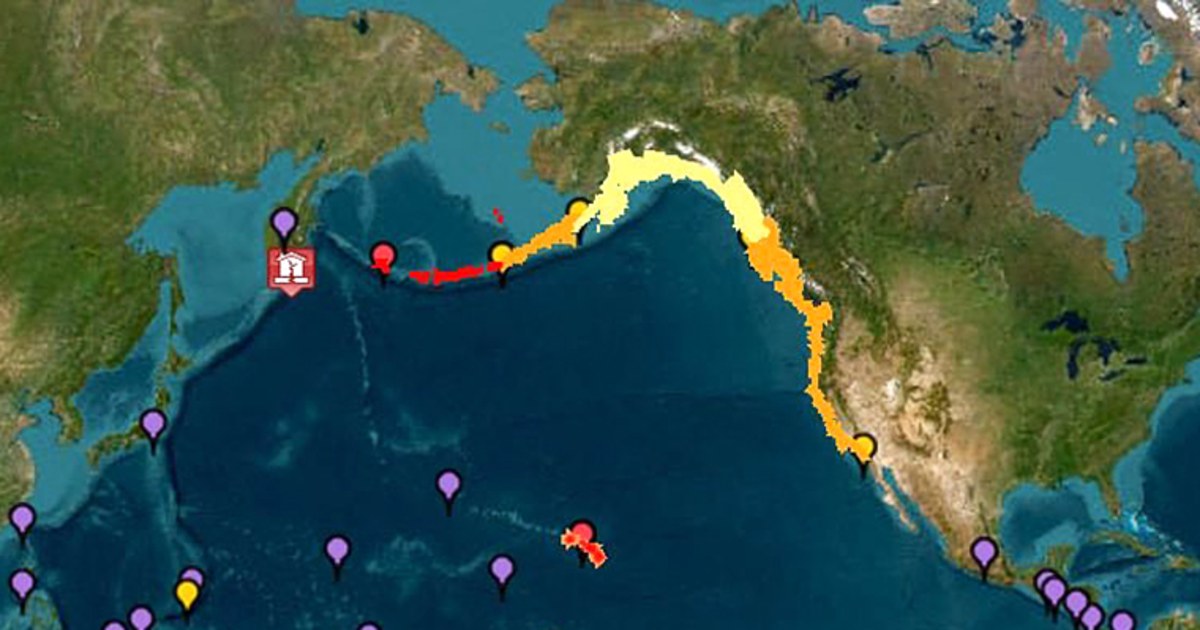Even after advisory passes in California, ‘ocean remains dynamic and dangerous’
The tsunami advisory for the San Francisco Bay area and other parts of California has passed, but “water levels are continuing to fluctuate,” forecasters said.
“The ocean remains dynamic and dangerous,” the National Weather Service for the region said this afternoon, warning of strong currents and other hazards.
The weather service announced shortly after 11 a.m. PT that the tsunami advisory for the Bay Area and the California central coast had been canceled.
Around 2:40 p.m., the tsunami advisory for Southern California was canceled.
But strong rip currents will remain for the next couple of days, and the weather service for Los Angeles warned beachgoers to check with lifeguards before they enter the water.
24 aftershocks of magnitude 5 or more followed huge quake
The massive 8.8-magnitude earthquake off Russia’s eastern coast, which caused tsunami alerts for a wide swath of the Pacific, was followed by at least 24 significant aftershocks, officials said.
Twenty-four aftershocks of magnitude 5 or greater had been recorded as of midnight ET, the U.S. Geological Survey said. They included 6.9- and 6.3-magnitude aftershocks, the agency said.
The earthquakes happened in the “Kuril-Kamchatka subduction zone,” which is where the Pacific plate subducts — or slides under — the North American plate, the USGS said.
“This wasn’t just a single point on a map — USGS modeling shows the quake ruptured a fault zone roughly 500 km long and 150 km wide, caused by the massive Pacific plate diving beneath the North American plate in one of the fastest subduction zones on Earth,” the USGS said.
Cruise passengers stranded in Hawaii after tsunami warning prompted ship to leave port

Rebecca Cohen and Stephanie Fuerte
Amanda Berry and her family had ventured off their Norwegian Cruise Line ship in Hawaii on an excursion to a volcano in Hilo when their phones started buzzing with tsunami alerts.
Berry told NBC News she wasn’t fazed at first — she’s from Houston, after all, where, she said, she often gets alerts that amount to nothing.
That was until they got off the tour buses and began exploring the volcano. Almost immediately after they disembarked, Berry said, employees started yelling at her group: “Go back, go back, go back. Your ship is going to leave early. You’re going to miss it.”
The ship had been told to leave the port immediately and get out to sea, where it would be safe from tsunami waves, Berry said.
They inched through traffic and pulled up to the port as the ship was closing its gates, Berry recalled. “It was at that moment where I actually got scared,” she said.
After they spending spent some time reassuring their loved ones that they’d be fine, “we felt pretty confident that we were going to be OK,” Berry said.
“We knew that we would be safe. We had confidence in the Hawaiian people, Hawaiian shelters, and also [Norwegian Cruise Line] getting us to a safe place,” Berry said. They had been stuck at a shelter for longer than expected, in less than favorable conditions, she added, but the people in Hilo “opened their hearts to us.”
Berry, who goes by “Mandy the Cruise Planner” on social media, has been documenting her experience on TikTok, racking up hundreds of thousands of views on the series.
She had plenty of praise for the Norwegian Cruise Line employees but expressed some frustration with the company’s delayed communications and broken promises about when the ship will return to retrieve them. She’s hoping for a refund on the excursion that got derailed.
Even still, Berry has been trying to make lemonade out of lemons.
“I would still do this cruise again,” she said. “Maybe that makes me a little odd or maybe even a little bit crazy, but I’m trying to take it all in a stride and just be appreciative that, hey, if something bad is going to happen to you, at least it’s happened in paradise.”
Pictures: Scenes from Russia of tsunami and quake damage

Roisín Savage
Hawaii cancels tsunami advisory
The Hawaii Emergency Management Agency issued an all clear for the entire state.
New Zealand: Strong and unusual currents expected
Coastal areas of New Zealand will experience strong and unusual currents and unpredictable surges at the shore after the Kamchatka earthquake, its National Emergency Management Agency warned.
The areas under threat include coastal areas of the North Island, Great Barrier Island, the South Island, Stewart Island and the Chatham Islands.
“Strong currents and surges can injure and drown people. There is a danger to swimmers, surfers, people fishing, and anyone in or near the water close to shore,” the agency warned early Thursday local time (Wednesday afternoon ET).
People who live on boats or at marinas are urged to leave and move to shore and avoid beaches and shore areas. Flooding near the shore is not expected.
The agency said tsunami activity has already reached parts of the country.
“The first currents and surges are unlikely to be the largest and are expected to continue over many hours,” officials said.
What to know about the Russian earthquake and global tsunami warnings
Quake strikes Russia’s remote Far East, triggering tsunami
- The powerful 8.8-magnitude earthquake struck today. Russia’s Tass news agency reported from the biggest city near the epicenter, Petropavlovsk-Kamchatsky, that cars swayed in the street and cabinets toppled over in homes. The first tsunami wave in Russia hit the coastal area of Severo-Kurilsk.
One of the strongest earthquakes in history
- The earthquake is tied for the sixth-largest ever recorded, and ot is the world’s largest since the 2011 earthquake off Japan that set off the Fukushima tsunami and nuclear meltdown, according to the U.S. Geological Survey.
Tsunami waves reached Pacific coast
- The first waves reached Hawaii around 7:30 p.m. local time (1:30 a.m. ET). Waves also hit California, Washington and Japan, where nearly 2 million people were asked to evacuate.
Hawaii: Every county issued an all clear to return to evacuation areas
All counties in Hawaii have issued the all clear to return to tsunami evacuation areas, the state Transportation Department said.
No damage has been reported to state highways, and all airports have resumed operations. Waterside checks are still being conducted, but landslide operations of ports have been cleared, and port gates are open.
Tsunami flooding, quake damage observed on Russian island
Homes and services facilities have been partially damaged in the Severo-Kurilsk municipality of Russia, officials said.
A tsunami threat has been lifted from Severo-Kurilsk municipality on Sakhalin Island in the Pacific Ocean, north of Japan.
The Russian Emergency Situations Ministry said other damage included flooding at the Severo-Kurilsk port and the adjacent Alaid fishing enterprise.
People in Japan evacuate to rooftops after tsunami alert
Video captured people gathering on top of roofs in the northern Japanese coastal community of Mukawa after a tsunami alert was issued for the country. People in Tokyo were also warned to stayed away from beaches.
Earthquake was the biggest in Russia in more than 70 years
Authorities in Russia’s far-east Kamchatka region have called the earthquake “a remarkable event,” saying it’s the biggest tremor there since 1952.
Temblor Inc. CEO Ross Stein, a lecturer in geophysics at Stanford University, said the event was preceded by a rare foreshock sequence on July 22.
Stein said it appears similar to the 1952 earthquake, which reached a magnitude of 9, according to the U.S. Geological Survey.
Seventy-five or so years might be a reasonable repeat time for quakes of that size, given the rate of subduction along the megathrust zone, he added.
Water levels still fluctuating along parts of California coast
Water levels continue to fluctuate greater than a foot along the coast at Point Reyes, California, according to the Bay Area National Weather Service office. Point Reyes is about 30 miles northwest of San Francisco.
A tsunami advisory remains in effect there until further notice.
Noem says threat of major tsunami has ‘passed completely’
Homeland Security Secretary Kristi Noem said the threat of damage from a “major” tsunami on the U.S. coast has “passed completely.” Noem made the comments during a visit to Chile.
Video shows Russian camping tent shaking violently
Video shared on Instagram shows a tent shuddering and swaying in the Kamchatka earthquake.
The video, taken by a woman who said she was “glamping,” showed the tent and furniture inside furiously shaking as the region was rocked by a historic tremor.
The woman who posted the video said she’d be scared if it weren’t for her experience living on Lake Baikal, in southern Siberia, Russia, an area prone to earthquakes.
Chart: The Russia quake was one of the strongest in history
The 8.8-magnitude quake that triggered the tsunami warnings was one of the most powerful quakes since 1900, data from the U.S. Geological Survey shows.
Tsunami advisory canceled for some coastal areas of California
The NOAA has canceled the tsunami advisory for some coastal areas of California from the California/Mexico border to Rincon Point, California, located 15 miles southeast of Santa Barbara. This means the Los Angeles area is no longer under a tsunami advisory.
However, a tsunami advisory remains in effect from Rincon Point north to the Humboldt/Del Norte line — including the San Francisco Bay.
A tsunami warning also remains in effect for the California coast from the Humboldt/Del Norte line to the Oregon/California border.
Kremlin: All tsunami warnings worked in a timely manner
Kremlin spokesperson Dmitry Peskov said all tsunami warning systems worked “in a timely manner” following the massive earthquake, and people were evacuated from endangered regions.
“In general, the seismic resistance of the buildings proved itself, so thank God there are no victims,” he said during a press call. “Technological preparedness proved itself and was at a high level.”
What is a tsunami?
We’ve seen the damage a tsunami can do with videos of the 2011 Tōhoku earthquake and tsunami in Japan, but the phenomenon has been difficult to describe.
An analysis of tsunami science published on the National Oceanic and Atmospheric Administration website notes that there’s still no agreed-upon metric for measuring a tsunami.
The tsunami page of ready.gov still measures tsunamis vertically, as if they’re regular ocean waves, and states, “A tsunami is a series of enormous ocean waves caused by earthquakes, underwater landslides, volcanic eruptions, or asteroids.”
That often leaves vertical measurements that mimic the gauging of daily ocean waves, but the two waves are quite different. Last night, Gov. Josh Green tried to explain the difference as he noted that a 3-foot pulse from the ocean was likely in Hawaii.
“This is not like a wave that comes across the shore, a 3-foot wave,” he said at a news conference. “This is a longitudinal wave with great force.”
That language mimics the NOAA-hosted analysis, which states, “Tsunamis are long waves of small steepness.”
In other words, much of their weight isn’t coming down from top to bottom, but rather from back to front as they rush onto dry land. A top-to-bottom breaker of a tsunami has happened, but the typical tsunami seems to take the form of a stealth wave below the surface and rushes in rapidly.
Ocean scientists at the University of Western Australia note that a tsunami gains speed as its ocean path loses depth. It also gains vertical height.
“It is not just a 3-foot wave,” Green said. “It is a forceful wall of water.”
Sea lions jump into sea as earthquake strikes

Reuters
Video from Antsiferov Island, an uninhabited volcanic island of the Kamchatka Peninsula, showed sea lions lounging on rocks jumping into the sea, as rocks started to tumble down the nearby cliff during the earthquake.
A tourist shot the video on a ship during a nature day trip near the island.
The island is known as a natural habitat for Stellar sea lions.
This was the strongest earthquake globally since 2011

Kathryn Prociv and Minyvonne Burke
The earthquake was the strongest globally since 2011 and is among the top 10 strongest detected worldwide. Kahului, Maui, saw waves as high as 5.7 feet, while Hilo saw waves of 4.9 feet. Waves were as high as 1 foot in Honolulu and 3.9 feet in Hanalei.
Over in California, Crescent City saw waves up to 3.6 feet, and Arena Cove saw 3-foot waves.
The worst is over, but tsunami advisories remain for Alaska, Hawaii and parts of the West Coast. Tsunami activity is expected to continue this morning, with rapid tidal level swings creating hazardous conditions.
Klyuchevskoy volcano in Kamchatka erupts
The Klyuchevskoy volcano in Kamchatka has erupted, according to the Kamchatka Branch of Geophysical Survey.
The agency shared videos on Telegram showing the powerful glow of the explosion and lava descending the western slope of the volcano.
Video shows 15-foot water drop at Maui harbor amid tsunami warning

Will Clark
Video from Maui County officials shows an approximate 15-foot water drop in Kahului harbor as the first tsunami waves approached Hawaii’s coast. No significant damage has been reported across the state as officials urge people to seek higher ground.
Tsunami waves in Russian region are more than 10 feet high, state media says
Russia’s remote region, struck by a massive 8.8-earthquake, saw tsunami waves reaching more than 13 feet high off the coast, state media reported today, citing weather monitoring authorities.
A tsunami with waves of almost 10 feet was recorded in the Yelizovsky district of Kamchatka, said Sergei Lebedev, Kamchatka region emergency situations minister, who added the height of the waves is estimated visually.
Surgeons in Russia secure patient during powerful earthquake

Will Clark
Medics in Petropavlovsk-Kamchatsky, Russia, secured a patient during surgery despite a powerful magnitude-8.8 earthquake, according to the region’s Health Minister Oleg Melnikov.
“Despite the danger, the doctors remained calm and stayed with the patient until the very end,” Melnikov wrote, adding that currently the patient is out of danger.
A 3.6-foot wave in Crescent City is California’s biggest recorded wave
A tsunami wave of 3.6 feet recorded in Crescent City was the highest in California, Reuters reported, citing the National Tsunami Warning Center.
The coastal city, hit by tsunamis in 1964 and 2011, is still under a tsunami warning. The National Weather Service advises people to stay away from beaches, harbors and piers until alerts are lifted.
Waves up to 13 feet could hit French Polynesia

Reuters
Authorities in French Polynesia warned the population of several of the Marquesas Islands to expect tsunami waves up to 13 feet (4 meters) high in the early hours of today.
They said the waves could hit the islands of Ua Huka, Nuku Hiva and Hiva Oa.
“Our armed forces in French Polynesia are on alert as a precautionary measure, to be ready to assist our fellow citizens and state services in potential search and rescue operations or medical evacuations,” French Defense Minister Sebastien Lecornu said on the social media platform X.
Residents were urged to move to higher ground and follow official instructions, including securing boats or moving them away from the shore.
Japan downgrades tsunami warnings

Arata Yamamoto and Mithil Aggarwal
Japan’s meteorological agency has downgraded some of its tsunami warnings to advisories.
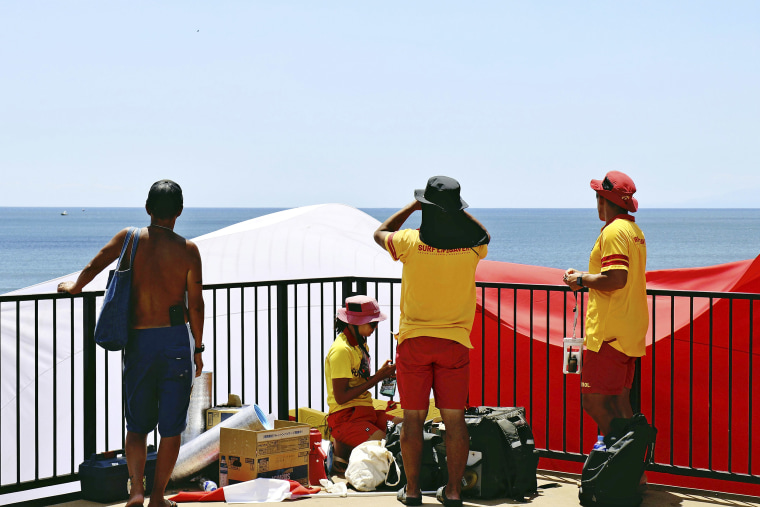
All areas except for the Pacific Coast of northern Hokkaido island and the northern Tohoku region of Honshu main island have been downgraded to an advisory, Masashi Kiyomoto, an agency official, told reporters today.
Tide gauge in Port San Luis on the central California coast shows rapid and damaging surge
The National Weather Service in Los Angeles said a rapid and damaging surge caused sea levels at Port San Luis to rise from low tide to high tide within minutes.
“Waters will recede, but could return multiple times through the next 24 hours, and the first wave may not be the largest,” it said on a X post.
The tsunami advisory is still in effect for the entire California coast.
Hawaii cancels evacuation order, asks people to watch for damage
Hawaii County has canceled evacuation orders for its coastal zones, allowing people to return to their homes, its civil defense agency said in a post on X, after the tsunami alert for the state was lowered to an advisory.
“Use caution in returning and watch out for damage,” it said, adding that beach parks will remain closed.
NOAA issues tsunami warning for parts of South Pacific
The National Oceanic and Atmospheric Administration has issued a tsunami threat alert for parts of the South Pacific, including Papua New Guinea, the Solomon Islands and Vanuatu.
Local residents should be aware of “potential dangerous coastal flooding and/or strong and unusual currents dangerous to those in or very near the water,” the U.S. Embassy to Papua New Guinea said.
The agency also advised people in coastal areas to prepare to move to higher ground immediately if necessary.
Japan reports waves more than 4 feet high
Japan’s meteorological agency has updated its website to reflect that waves of more than 4 feet were detected at Kuji port in the northern Iwate prefecture on the Honshu mainland, the highest so far to reach Japan.
In a speeded-up weather cam video of Kuji port aired by Japanese broadcaster NHK, it appeared to be more of a gradual change in water level than a single 4-foot wave.
Yoshimasa Hayashi, the Japanese government’s top spokesperson, said there had been just one minor injury reported in Hokkaido, a woman in her 60s who tripped as she was evacuating.
“It is expected that high tsunami levels will continue for at least one day,” he said, “and there is also the possibility that the tsunami will rise above the current level if it coincides with high tide.”
Hawaii ‘past the worst part’: Pacific Tsunami Warning Center

Will Clark
Chip McCreery, director of the Pacific Tsunami Warning Center, said Hawaii is “past the worst part” of the statewide tsunami warning, which has now been lowered to an advisory. McCreery added that the state is unlikely to “see any impacts bigger than we’ve already seen.”
Waves up to a foot high in Guam
Tsunami waves up to a foot high have reached the U.S. island territory of Guam, authorities said.
Similar wave heights will continue, but they are expected to gradually diminish in the coming hours, the Guam Office of Civil Defense said in a statement.
Possible effects include changes in sea level, minor flooding in coastal areas, and strong, unusual currents near the shore, it added.
China lifts tsunami alerts for Shanghai and Zhejiang
China lifted yellow tsunami alerts for the city of Shanghai and Zhejiang province, according to the latest assessment by China’s Tsunami Warning Center under the Ministry of Natural Resources.
The alerts warned that tsunami waves from the earthquake off the coast of Russia could reach Shanghai by evening local time. The city relocated more than 280,000 people and suspended multiple flights, sea, and rail transportation services this morning as it prepared for the potential tsunami as well as the arrival of Typhoon Co-may.
Tsunamis are extremely rare in China. According to historical records cited by the Chinese Academy of Sciences, only 10 tsunamis have occurred in the past 2,000 years.
Pictures: Japan beach evacuations

Roisín Savage
Waves reach coast of Washington state, weather service says
The first waves hit the Washington state communities of La Push and Westport in the past hour, the National Weather Service Seattle said in a post on X, citing tide gauges.
The weather service did not say how high the waves were, but forecasters have said the waves were expected to be under one foot for much of the West Coast.
Tsunami threat downgraded to advisory in Hawaii
The Pacific Tsunami Warning Center has downgraded its threat warning for Hawaii to an advisory.
“Based on all available data a major tsunami is not expected to strike the state of Hawaii,” it said in a bulletin. “Strong currents may occur along all coasts that could be a hazard.”
Those who have evacuated may safely return home based on county assessments and directives, officials said.
In a separate bulletin, the center also canceled its tsunami advisory for Guam and the Northern Mariana Islands.
Japan’s Fukushima nuclear plants evacuate workers
All workers were evacuated from Japan’s Fukushima nuclear power plants after an 8.8-magnitude earthquake off Russia raised tsunami fears.
No injuries have been reported so far, the Tokyo Electric Power Company said in a post on X, with the discharge of radioactive wastewater from the Fukushima Daiichi plant suspended to “ensure absolute safety.”
There are no abnormalities in facilities at either the Fukushima Daiichi or Fukushima Daini plants, it said. “We will continue to closely monitor tsunami information and any impacts to the plants.”
In 2011, a powerful earthquake and tsunami crippled the Fukushima Daiichi plant.
Tsunami reaches California coast, weather service says
Waves have reached the California coast, the National Weather Service said in a post on X, adding that they were showing up in Arena Cove and making their way down the coast.
“First Tsunami waves are beginning to impact the coast with clear waves being recorded at the Crescent City and Humboldt Bay tide gauges,” NWS Eureka said separately.
“Waves will continue to build in through the night and will become more dangerous as we approach high tide,” it added.
Hawaiian Airlines says it’s resuming flights
Hawaiian Airlines says it is resuming flight operations as airports reopen.
Hawaiian and its sister airline, Alaska, had earlier put flights on hold as Hawaii braced for possible tsunami waves.
Alaska Airlines operations will resume in the morning, Hawaiian Airlines said. Guests traveling to, from or within the Hawaiian Islands should continue to check the status of their flight, the airline said.
Hawaii Gov. Josh Green said earlier that all flights in and out of Maui had been canceled for the night.
‘You can’t even get in’: Hawaii gas stations crowded amid tsunami alert

Will Clark
Nearly 2 million people told to evacuate in Japan
Arata Yamamoto and Jackson Peck
More than 1.9 million people in Japan are under evacuation alerts.
The evacuation advisories cover 207 cities and towns across 21 prefectures, according to the nation’s Fire and Disaster Management Agency.
Hawaii records wave of nearly 6 feet; ‘not over yet,’ officials say
Waves of nearly 6 feet were recorded in Maui, according to NOAA data.
The Hawaii County Civil Defense Agency warned that follow-up waves over the next several hours could be larger. “These massive waves can wrap around the island shore, so impacts may occur at any point along the coast,” it said on X.
“It’s not over yet,” it added.
All flights in and out of Maui canceled
While Hawaii airports have not been affected by waves, all flights in and out of Maui have been canceled for the night, Gov. Josh Green said, adding that about 200 people were sheltering in the terminal.
He said that there had been no power disruptions in the state and that there were no plans to shut off power pre-emptively.
No ‘wave of consequence’ so far, Hawaii governor says

Jennifer Jett and Bella LoBue
Hawaii has so far “not seen a wave of consequence, which is a great relief to us,” Gov. Josh Green told reporters. “It’s kind of a blessing to not be reporting any damage.”
But he cautioned that “we have seen significant water recede several times in Haleiwa, and there were two waves that were measured coming through the Midway Atoll, so that’s been our concern.”
“Until we see what happens on the Big Island and the full wraparound of the islands, we won’t feel that we are in a position to start seeing and saying that we’re kind of in the clear,” Green said, adding that it would be at least two to three hours before that.
“So far, though, at the moment, so good,” he said.
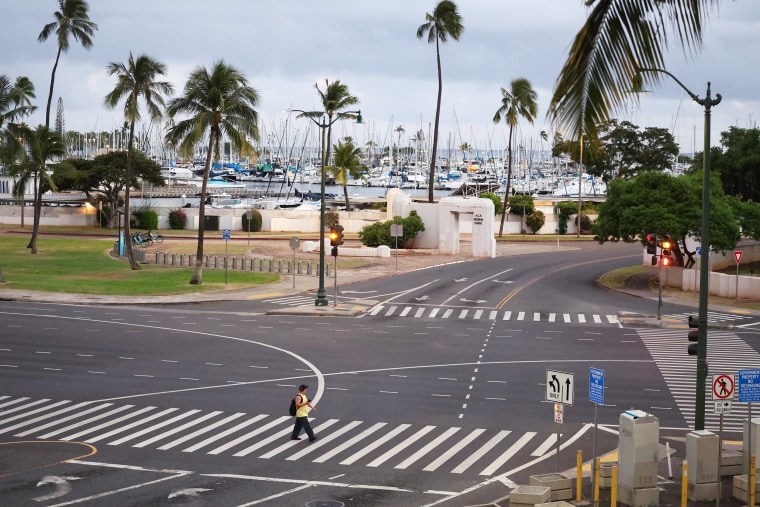
Tsunami waves now affecting Hawaii
Tsunami waves are now affecting Hawaii, Honolulu’s emergency department said in an alert.
“Destructive tsunamis expected,” it said, urging people in warning zones to evacuate.
Waves have hit Japan, but they’re small if measured vertically
Ocean pulses from the Kamchatka Peninsula earthquake have already come ashore in Japan, but their size might seem puzzling.
The largest waves so far were measured at almost 24 inches, small waves compared with ocean surf. They arrived on the Japanese islands of Hokkaido and Honshu shortly after 1 p.m. local time, the country’s meteorological agency said.
The two Japanese islands were earlier hit by even smaller waves of about 12, 16 and 20 inches. No deaths or major damage have been reported so far.
Height may be deceiving: Tsunamis can be relatively low if they’re measured vertically, but they’re more often powered by their long length, which brings with it more potency than that of an everyday ocean wave.
An academic analysis of tsunami science on the National Oceanic and Atmospheric Administration website says there is no agreed-upon measure of potency for the waves, but it asserts: “Tsunamis are long waves of small steepness.”
Earthquake could be one of the largest ever recorded
The massive earthquake that struck off Russia could be one of the biggest ever recorded if its 8.8-magnitude remains unchanged.
According to the U.S. Geological Survey, the tremor off Russia’s Kamchatka Peninsula is tied for the sixth-largest on record, along with a 2010 earthquake off Chile. The agency said that the earthquake was shallow at a depth of about 13 miles and that it was centered about 75 miles east-southeast of the Russian city of Petropavlovsk-Kamchatsky.
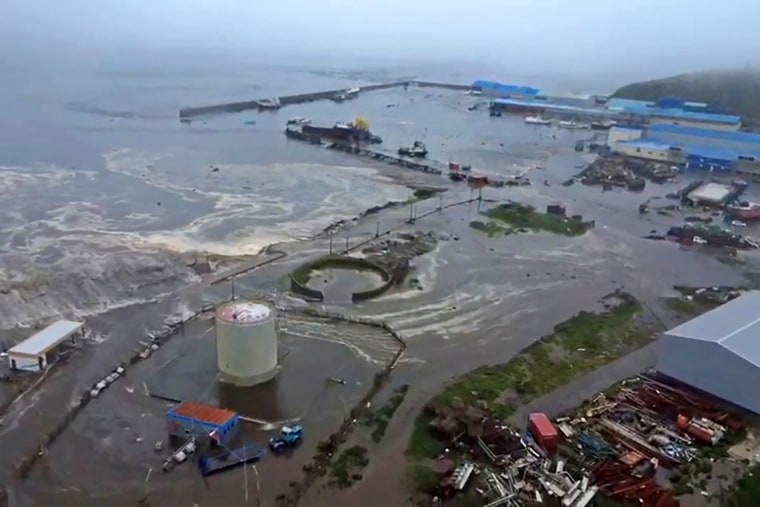
It is the world’s largest earthquake since the 2011 earthquake off Japan, which had a magnitude of 9.1 and set off the Fukushima tsunami and nuclear meltdown. In Russia, it was the largest earthquake since one in the same area in 1952 that measured 9.0.
The biggest earthquake on record is the 1960 Valdivia earthquake in Chile, which had a magnitude of 9.5.
Hawaiian Airlines, Alaska Airlines put flights to Hawaii on hold
Hawaiian Airlines and Alaska Airlines said flights to Hawaii were on hold as the merged sister carriers monitor the expected tsunami and its aftermath.
“We are holding flight departures to the Islands on Hawaiian Airlines and Alaska Airlines,” Hawaiian said in a statement. Flights in the air were ordered to return to the mainland or divert to a suitable airport, it said.
Ticket-holders were asked to check the statuses of their flights before they head to their departure airports. Travel plans affected by the flight pause could be eligible for waivers, Hawaiian said.
More information can be found here.
Tsunami’s first effects in Hawaii expected to be on Kauai coast
The effects of the tsunami waves are initially expected to appear on the coast of Kauai, followed by the Big Island about 20 to 30 minutes later, the Hawaii County Civil Defense Agency said.
“These massive waves can wrap around the island shore, so impacts may occur at any point along the coast. AVOID THE AREA,” the agency said on X.
Buildings damaged after 8.8-magnitude earthquake hits Russia
Witness videos captured the powerful 8.8-magnitude earthquake that struck Russia’s Kamchatka Peninsula in the Far East. The earthquake triggered a tsunami alert, with the first waves hitting the coastal area of Severo-Kurilsk.
Japan remains under tsunami warning, official says
Japan’s meteorological agency said tsunami warnings remained in place since waves were still being observed and asked those in the warning zones to remain in safe locations.
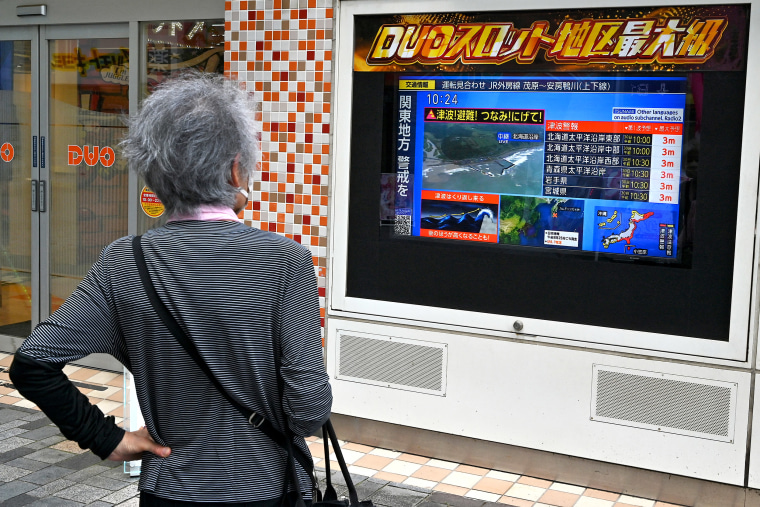
Agency official Masashi Kiyomoto said each wave cycle was lasting about an hour and that there had been two to three cycles so far. He said it was too early to say whether the waves were getting larger with each cycle.
Based on similar-sized earthquakes in the region in the past, the tsunamis could last for about a day, he said.
Visitors in high-rise hotels need to head to higher floors, Hawaii tourism chief says
Hawaii’s tourism chief last night said visitors in high-rise hotels and resorts should head to higher floors where possible.
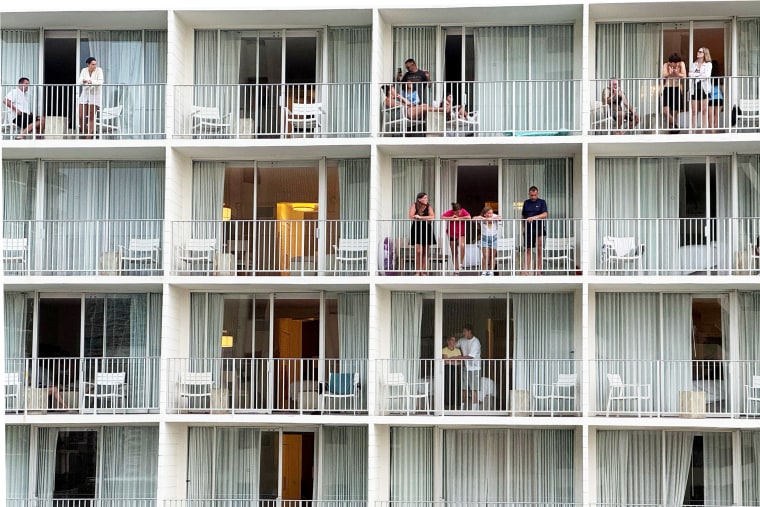
James Kunane Tokioka, state director of the Department of Business, Economic Development and Tourism, called such a move “vertical evacuation.”
“Properties along the coastline are being asked to evacuate vertically, four floors and above,” he said, meaning tourists should be at least on the fourth floor before any waves arrive.
The Waikiki coast in Honolulu is packed with high-rise hotels and resorts.
Japan reports biggest waves so far
Japan, where the earthquake was barely felt, has reported the biggest tsunami waves so far, measuring 60 centimeters, or almost 2 feet.
One arrived at 1:11 p.m. local time (12:11 a.m. ET) in the town of Hamanaka in the southern region of the northernmost island of Hokkaido, according to Japan’s meteorological agency. The other was at 1:03 p.m. at Kuji port in Iwate Prefecture on Japan’s main island of Honshu.
Earlier, Japan reported waves on Honshu and Hokkaido of about 12 to 20 inches. Officials had said waves could reach as high as about 3 feet.
Coast Guard orders all commercial vessels to evacuate commercial ports in Hawaii
The Coast Guard has ordered all commercial vessels at commercial ports in Hawaii to evacuate.
In a post on X, the agency attributed the order to the captain of the Port of Honolulu. It also said all harbors in the state have been closed to incoming traffic.
In its advice about responding to a tsunami, the federal website ready.gov says, “If you are in a boat, go out to sea.”
Damage along Hawaii’s coastlines expected
The governor of Hawaii tonight emphasized that tsunami effects could be real and costly, as potent ocean pulses from the 8.8-magnitude quake east of Russia’s Kamchatka Peninsula were expected at around 7:17 p.m. local time (1:17 a.m. ET).
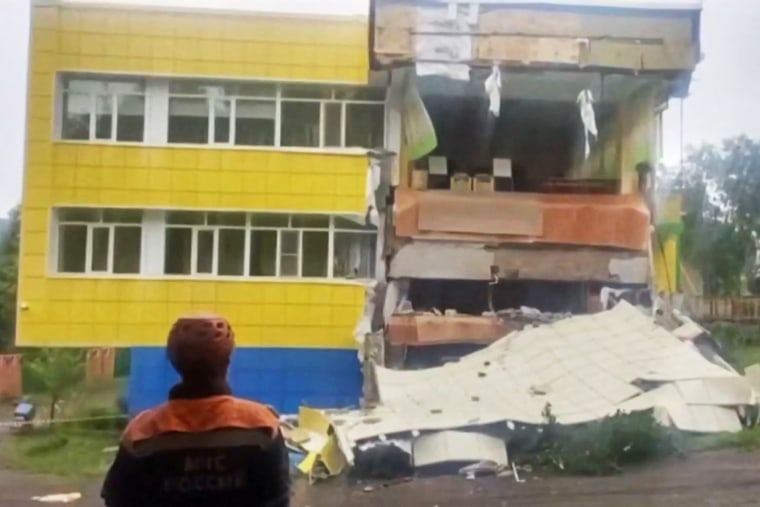
Gov. Josh Green said impacts are almost certain. “We do expect damage. We expect significant damage along the coastlines,” he said.
“We pray that we won’t lose any of our loved ones,” he continued.

